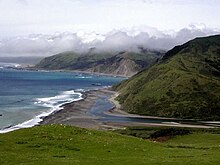

| Marine habitats |
|---|
| Coastal habitats |
| Ocean surface |
| Open ocean |
| Sea floor |
An estuary is a partially enclosed coastal body of brackish water with one or more rivers or streams flowing into it, and with a free connection to the open sea.[1] Estuaries form a transition zone between river environments and maritime environments and are an example of an ecotone. Estuaries are subject both to marine influences such as tides, waves, and the influx of saline water, and to fluvial influences such as flows of freshwater and sediment. The mixing of seawater and freshwater provides high levels of nutrients both in the water column and in sediment, making estuaries among the most productive natural habitats in the world.[2]
Most existing estuaries formed during the Holocene epoch with the flooding of river-eroded or glacially scoured valleys when the sea level began to rise about 10,000–12,000 years ago.[3] Estuaries are typically classified according to their geomorphological features or to water-circulation patterns. They can have many different names, such as bays, harbors, lagoons, inlets, or sounds, although some of these water bodies do not strictly meet the above definition of an estuary and could be fully saline.
Many estuaries suffer degeneration from a variety of factors including soil erosion, deforestation, overgrazing, overfishing and the filling of wetlands. Eutrophication may lead to excessive nutrients from sewage and animal wastes; pollutants including heavy metals, polychlorinated biphenyls, radionuclides and hydrocarbons from sewage inputs; and diking or damming for flood control or water diversion.[3][4]
- ^ Pritchard, D. W. (1967). "What is an estuary: physical viewpoint". In Lauf, G. H. (ed.). Estuaries. A.A.A.S. Publ. Vol. 83. Washington, DC. pp. 3–5. hdl:1969.3/24383.
{{cite book}}: CS1 maint: location missing publisher (link) - ^ McLusky, D. S.; Elliott, M. (2004). The Estuarine Ecosystem: Ecology, Threats and Management. New York: Oxford University Press. ISBN 978-0-19-852508-0.
- ^ a b Wolanski, E. (2007). Estuarine Ecohydrology. Amsterdam: Elsevier. ISBN 978-0-444-53066-0.
- ^ Silva, Sergio; Lowry, Maran; Macaya-Solis, Consuelo; Byatt, Barry; Lucas, Martyn C. (2017). "Can navigation locks be used to help migratory fishes with poor swimming performance pass tidal barrages? A test with lampreys". Ecological Engineering. 102: 291–302. Bibcode:2017EcEng.102..291S. doi:10.1016/j.ecoleng.2017.02.027.